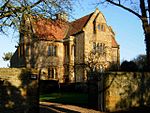Blisworth Limestone Formation
Bathonian StageGeologic formations of the United KingdomJurassic EnglandJurassic System of EuropeLimestone formations of the United Kingdom ... and 1 more
Rock formations of England
The Blisworth Limestone Formation is a geological formation primarily consisting of limestone deposited during the Bathonian stage of the Middle Jurassic, found in the Jurassic ridge which extends north and south through England. It was laid down in the shallows of the Jurassic sea and is part of the more widely defined Great Oolite Group. It was previously known as the Great Oolite Limestone, White Limestone and the Snitterby Limestone Formation. It is the lateral equivalent of the White Limestone Formation From the Jurassic ridge it extends eastwards below the later deposits and in the North Sea terminology, it is part of the West Sole Group. (Cameron p. 74)
Excerpt from the Wikipedia article Blisworth Limestone Formation (License: CC BY-SA 3.0, Authors).Blisworth Limestone Formation
Towcester Road,
Geographical coordinates (GPS) Address Nearby Places Show on map
Geographical coordinates (GPS)
| Latitude | Longitude |
|---|---|
| N 52.171 ° | E -0.954 ° |
Address
Towcester Road
Towcester Road
NN7 3DL , Tiffield
England, United Kingdom
Open on Google Maps








